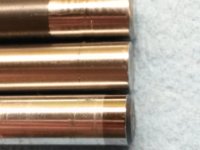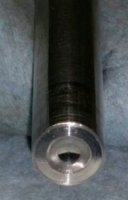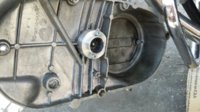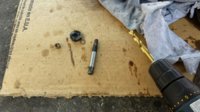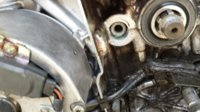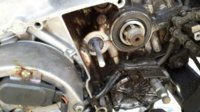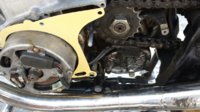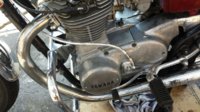Received an interesting 'status update' from DogBunny on his version-1 bimetal pushrod.
From DogBunny:
It's been approx. 14 months since I put push rod # 2M002 on my bike.* It gets ridden daily, but usually for very short trips to the post office or store.* It gets 20 miles on it in a day fairly commonly.* Over 30 miles a day is pretty rare.* 60 to 100 miles in a day maybe 6 times a year.* Riding it to Luchenbach from Austin once a year.
*
I'd really like for you to see the rod in person, it's sort of interesting.* The dimples on the ends, the "coupling"and rod straightness are all like new.* However, the steel part of the rod has corrosion – isn't it made from SS?* Doesn't make sense to me – the "air"side of the rod is covered with chain lube, and the engine side is covered with oil.* Maybe the flung-off chain oil on the rod is adulterated with water?* Maybe the (stainless ?) steel used is susceptible to corrosion?* To make sure I'm not crazy, I compared it to rod # 2M005 which is still un-used.* The steel part on it looks nice and shiny in comparison.
*
Should mention that bike is kept outdoors, covered, but very susceptible to condensation.* I try to avoid wet roads, but I get caught in the rain occasionally.
*
For reference, I have circled the same pit on the rod in each picture.* This is the worst mark on the rod, very easily detected with a fingernail.* The arrow is where the rod contacts the oil seal.* The seal mark has to be the "rest"position.* I find this mark curious – does the rod rotate while at rest?


*************
Reply:
Hey, William. Thanx for the pushrod pics. Been studying them up close, and re-researching 304 stainless properties.
I ordered the rods from an eBay metals supplier back then, and they had some surface blemishes (and slight bending) when received. I figured that was from supplier storage and neglect, and the usual eBay product 'dumping' on the gullible (me) public.
I straightened the rods, and polished-out the blemishes best I could. But, your pics show that those blemishes may have been more than skin deep, and are again revealing themselves.
This is a good catch. 304 stainless isn't supposed to blemish like that, as in your pics. The only cautions I could find for 304 stainless is to avoid strong sulphuric and hydrochloric acics. If those existed on that sidecover area, there would be much more serious problems down there.
I probably should find a different supplier, as in non-eBay.
I don't see the blemishes as detrimental to the structural integrity of the pushrod, but I do have a concern if they accelerate the seal wear.
The pushrod rides inside the mainshaft, and will spin with the mainshaft if sufficient contact and friction is made, especially in compression against the ball and mushroom rod, like when the clutch lever is pulled. With clutch lever released, the rod may or may not spin with the mainshaft. Depends on how much inner drag/contact is made with the mainshaft bore, versus the holding friction of the seal.
The only time that the mainshaft isn't spinning is when you're stopped, in gear, with the clutch pulled.
I'll take your pics and update the 'pushrod' thread. And try to figure out how to avoid this quality-control issue, without spending $100 for precision ground laboratory grade shafting...
 If you decide to make these, consider me standing in line.
If you decide to make these, consider me standing in line.
